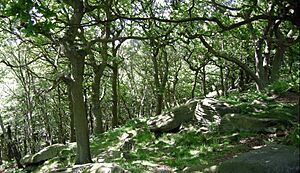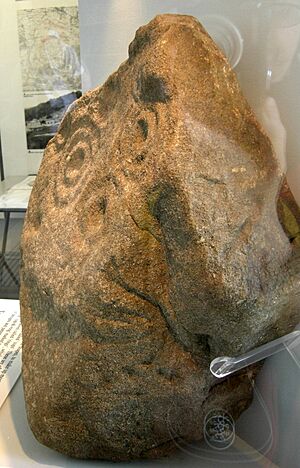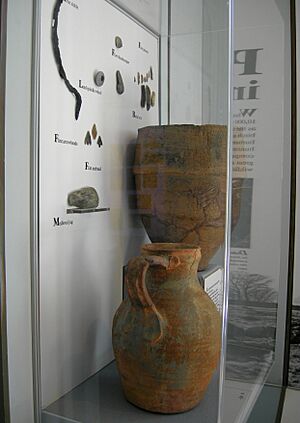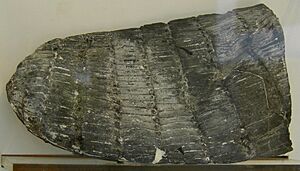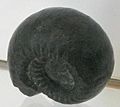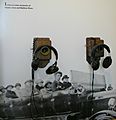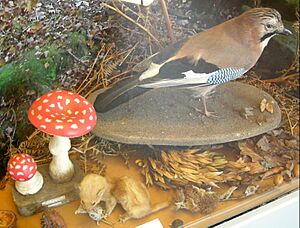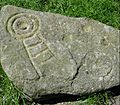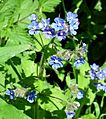Bracken Hall Countryside Centre and Museum facts for kids

Bracken Hall Museum
|
|
| Established | Early 1980s; 1989 at Bracken Hall. |
|---|---|
| Location | Glen Road, Baildon, Shipley, West Yorkshire, England BD17 5EA |
| Type | Children's museum, Natural history museum, Local archaeology museum, Interpretation centre |
| Public transit access | Shipley Glen Tramway or bus from Bradford Interchange |
The Bracken Hall Countryside Centre and Museum is a fun place for kids! It's a children's museum and a nature centre that opened in 1989. You can find it on the edge of Baildon Moor, close to Shipley Glen in West Yorkshire, England.
In 2013, the local council stopped funding the museum. But the Friends of Bracken Hall group worked hard to get it reopened. With help from Baildon Town Council, the museum welcomed visitors again in April 2016.
Exploring the Museum
The Museum Building and Front Garden
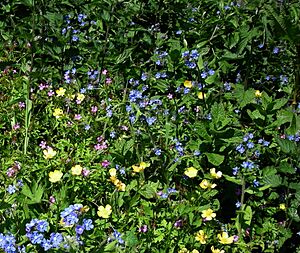
The Old Building
The museum is in an old house built around the 1890s. It's made of strong Yorkshire gritstone. This building used to be a bailiff's house, then a farm house. It still has its original big, old front door!
The house has a traditional design with two rooms on each side of the front door. Stairs in the middle lead up to two bedrooms on each side. Today, the Bradford City Council added a new room on the left side. This is where you'll find the museum's entrance and reception desk. The two original front rooms downstairs are now the Archaeology room and the Exhibition room.
What You Can See
This children's museum is full of interactive displays for all ages. You can explore inside the museum's ground floor rooms. You can also walk through the back and front gardens, which are designed for discovering wildlife.
The whole museum area, including the nearby moor and glen, is used for special groups. These include "Wild Wednesdays" and guided walks. School groups also visit when the museum is closed to the public. You can arrange these visits by appointment.
The Front Garden
The front garden changes with the seasons. In May and June, you can see many wild flowers. These include green alkanet, herb Robert, and creeping buttercup.
Bird feeders attract different kinds of finches and tits. There's also an animal hutch for a rabbit or guinea pig. Sometimes, the animal can safely graze in the garden under supervision.
-
The front garden with Shipley in the distance.
-
Green alkanet, herb Robert, and creeping buttercup flowers.
The Entrance Room
-
Remains of a wasp nest for children to handle.
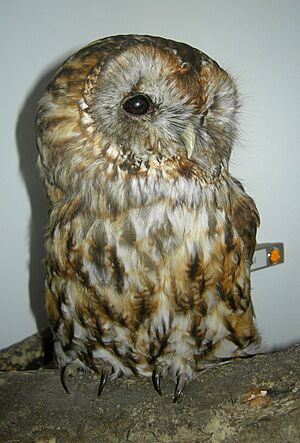
The displays in this room change often. This is because kids are very hands-on, and wildlife items can be delicate!
Video Microscope Fun
Near the reception desk, there's a tall, interactive video microscope. You can place a dish of natural objects, like houseflies, on the lighted tray. Then, you move the tray around to see them on the big video screen. The tray is at child-height, so everyone can join in. On the screen, a housefly looks bigger than your hand! This helps you see all its tiny details.
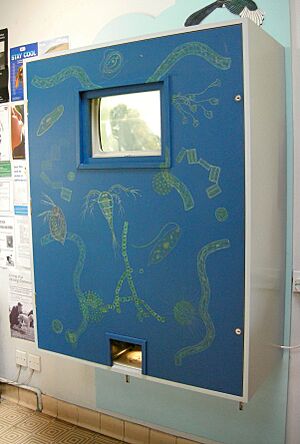
Fishtanks and Worms
Along the back wall, you'll find several fishtanks. They might have tadpoles, bullheads, goldfish, or tiny water fleas. In the far corner, there's a wormery where you can watch worms at work.
Bees and Wasps
There used to be an indoor beehive with a window for kids to watch the bees. It was taken down because of a problem called colony collapse disorder. Now, there's an information board about bees and a real honeycomb you can touch. The display teaches you about bee groups, their behavior, and how hives are built.
There's also a board about wasps. It explains their behavior and nest structure. It also tells you how wasps help control pests in organic gardens. Below the board, you can see the remains of a wasp nest. This lets you compare its papery feel with the waxy honeycomb.
Computer Nature Guide and Touch Box
This computer has a Dangerous Creatures CD-ROM. It's a program for children to learn about wildlife from other countries in a fun way. Near the computer, there's a box where you can put your hands in holes. You try to guess what natural objects you're touching!
Interactive Animal ID Displays
On the same wall, there are two interactive boards. One is for younger children. It has big wooden handles that make rabbits, birds, and other animals pop up from holes. The other board is for slightly older kids. It has glass panels with pictures or mounted animals behind them. You try to name the animals, then lift wooden flaps to see their names.
Garden Birds Display
Behind the entrance door, there's a glass case with mounted garden birds. It's low enough for young children to see them easily. You might spot a wren's nest and a tawny owl. This display also plays birdsong recordings, which helps kids learn to identify different bird calls.
Local Archaeology and History Room
This room shows off amazing finds from the past. It has archaeological, geological, and local history exhibits for both kids and adults. The most important item here is the Heygate stone.
The Heygate Stone
This special stone has ancient cup and ring marks carved into it. These marks were made in the Neolithic era, about 5,000 years ago! Larger engraved rocks are still on the moor. This smaller, more portable stone is kept safe in the museum. You can even see old plough-marks on it, showing why it needed protection.
The Heygate stone is one of the clearest examples of these ancient carvings. A special cast shows that two larger ring-marks were carved over others. The stone was found in 2001 near Baildon. It's believed to be part of a larger rock that was used for building walls. The landowner wanted the stone to stay at the museum, close to where it was found.
Local Finds
A glass case holds items from the Neolithic and medieval times, found around Baildon Moor. You can see an iron sickle and a Neolithic burial urn found in 1904. There's also a medieval jug and a lead spindle whorl. From the same area, you'll find Neolithic arrowheads, thumbscrapers, and piercers, all made from flint. There are even Roman coins, including one found in Shipley Glen.
Grinding Grain with a Quern-stone
You can try out an Iron Age beehive quern-stone! It has a wooden handle you can remove. There's plenty of grain to grind. Look at a drawing of how it works and try to figure out how to grind the corn. When you turn the top stone, the grain helps it spin easily. But the rough stone still grinds the corn. Just remember, the top stone can move sideways, so young children need to be careful with their fingers.
Local Fossils
See a display of fossils found nearby! There's the huge Calamites, which was like a giant horsetail plant. You can also see the small Gastrioceras, a type of ammonite. Other fossils include Lepidodendron, Stigmaria, Carbonicola, Dunbarella, and Lingula. All these were found around Baildon Moor.
Local Geology
An information board explains the local sedimentary rock. There's a display of small, loose stones you can touch. These include ironstone, iron slag, gritstone, coal, sandstone, and shale. The board also has a picture of Baildon Moor showing its layers of rock and faults. If you walk on the moor, you'll see these large rocks with their weathered layers.
Local Stories
You can listen to local stories through headphones. These "oral histories" are important for keeping the community's past alive.
-
Archaeology and local history displays.
-
More archaeology and local history displays.
-
An interactive quern-stone display.
-
Another view of the interactive quern-stone display.
-
Quern-stones at Cliffe Castle Museum, showing the central wooden spindle.
-
Geological samples for visitors to handle.
-
Headphones with recordings of local history from Shipley Glen and Baildon Moor.
Front Door Lobby
In the lobby, you can see the inside of the original, heavy front door. There are quiz sheets to help you identify wildlife. A board has numbered pictures of different animals and plants to identify. The quiz is fun for both kids and adults!
Various wildlife pictures and displays are changed regularly here.
Exhibition and Activity Room
This room was once a main room in the old farmhouse. Now, it's used as a gallery. You'll find reference books on a table that can help you with the wildlife quiz. This room is also used for school and group visits.
How We Study Nature: Past and Present
This display shows how people have studied plants over time. You can compare old ways, like focusing on classifying plants with dusty books and brass microscopes. Then, you can see modern ways, like getting muddy boots during fieldwork with cameras and field guides.
Autumn Nature Scene
Here's another example of taxidermy art. This display shows autumn seeds to identify. It also gives you a close-up look at some shy UK animals, like the weasel, shrew, and jay.
-
A 19th-century brass optical microscope.
The Back Garden
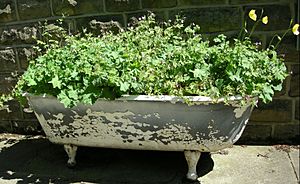
Back Yard Area
You can get to the back yard from the Entrance room's back door or by walking across the front lawn. The toilets are here, along with another animal hutch.
Side Garden Discoveries
In the side garden, there's a raised lawn with a "minibeast trapdoor." This is a light flap that children can lift to find small creatures hiding underneath. You might see slugs, snails, earthworms, woodlice, and millipedes.
On the lawn, there's another animal hutch. You'll also see a safety cage for old beehives, which are no longer used. A shed has bat-boxes on its side. Two old apple trees grow here, and there's a copy of a cup and ring stone for kids to touch.
Side Path Wonders
Along the side path, an old bathtub is filled with wild flowers. There's also a safety cage for the entrance to the indoor beehive, which is now empty. Even so, bumble bees still try to use the entrance in early summer! Wellington boots dry on a bench, as it can be muddy here for much of the year.
-
A minibeast trapdoor for children to observe slugs, woodlice, millipedes, and snails.
-
A backyard view of the hutch and shed with bat-boxes.
-
Cup and ring marks created by archaeologists using a deer antler pick.
-
A safety cage around the entrance to the indoor hive (now taken apart).
-
Disused beehives.
Pond Area
The children's dipping pond is a great place to explore! You can reach it from the side or front lawn. It's home to yellow flags, tadpoles, frogs, newts, and other pond life.
Baildon Moor and Shipley Glen
Right across the road from the museum is Baildon Moor. People have used this moor for fun and recreation for a long time. There used to be a Victorian funfair here! You can read its story on the wall of the Archaeology room. On the moor opposite Bracken Hall, there's also a neolithic stone circle.
Just a five-minute walk away is Shipley Glen. Some of Bracken Hall's nature walks happen here. This is also where the Roman coin in the Archaeology room was found. There's some parking on the edge of the moor for museum visitors. Remember, the museum gardens and moor can get muddy after rain, so boots are a good idea!
